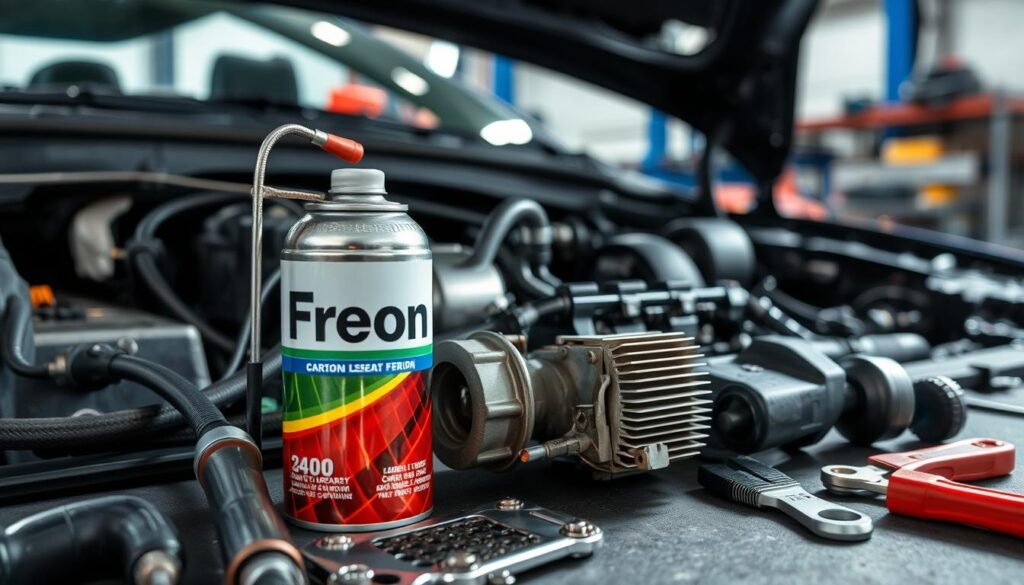Imagine driving on a hot summer day and your car’s AC stops working. You start to feel the heat and wonder about freon for car AC systems. I’ve been in that situation too. So, let me help you understand automotive ac refrigerant and car ac freon refill.
Your car’s AC is not just a luxury; it’s essential for comfort and safety. Knowing how your AC system works can prevent sweaty rides and expensive fixes.

This guide will cover car AC refrigerants, from the basics to environmental rules. Whether you like to fix things yourself or prefer a pro, you’ll learn how to keep your car cool.
Key Takeaways
- Freon is crucial for your car’s AC performance
- Modern vehicles use different types of refrigerants
- Regular AC maintenance can prevent costly repairs
- DIY recharging is possible but comes with risks
- Environmental concerns are shaping the future of automotive refrigerants
- Proper disposal of old refrigerants is essential for eco-friendliness
Understanding Car AC Systems and Refrigerants
Car air conditioning systems keep drivers cool in hot weather. At their core is the refrigerant, key to cooling.
The Role of Refrigerants in Automotive Air Conditioning
Refrigerants absorb heat from inside the car and release it outside. They change from liquid to gas and back, cooling the air inside.
Evolution of Car AC Refrigerants
The history of car refrigerants has changed a lot:
- R12: Used until the early 1990s
- R134a: Replaced R12 for environmental reasons
- R1234yf: A newer, eco-friendly choice
Today, R134a is still common, but newer cars use R1234yf.
Environmental Concerns and Regulations
Environmental impact has led to changes in refrigerants. New rules aim to cut down on greenhouse gas emissions from car AC systems. This has prompted the creation of refrigerants with lower global warming potential.
| Refrigerant | Global Warming Potential | Ozone Depletion Potential |
|---|---|---|
| R12 | 10,900 | 1 |
| R134a | 1,430 | 0 |
| R1234yf | 4 | 0 |
With stricter rules, the car industry is looking for new refrigerants. They want ones that are safe, perform well, and are good for the environment.
What is Freon and Why is it Important for Your Car’s AC?
Freon is key for keeping your car cool in the summer. It’s a refrigerant that moves through your AC system. It takes heat and humidity out of the air inside your car.
The term “freon” used to mean a specific brand of refrigerants. Now, it covers many types of AC coolants. Modern cars use refrigerants like R134a or R1234yf, which are safer than older types like R12.
Your car’s AC system needs freon to cool the air inside. As freon changes from liquid to gas and back, it moves heat out. This makes your car’s interior cool and comfortable.
- Absorbs heat from inside your car
- Releases heat outside the vehicle
- Removes humidity from the air
- Circulates through the AC system
It’s important to keep the right amount of freon in your car. Too little can make your AC less effective and even damage it. Regular checks and recharges keep your AC working well, so you stay cool.
Signs Your Car’s AC Needs a Refrigerant Recharge
Your car’s air conditioning is key to staying cool on hot days. If it’s not working right, it might need a recharge. Here are signs your car’s AC needs a top-up.
Decreased Cooling Performance
One clear sign is when your AC doesn’t cool like it used to. You might get warm air or it takes longer to cool. This usually means it’s time for a coolant refill.
Strange Noises from the AC System
Odd sounds when you turn on the AC can mean trouble. Hissing or bubbling noises might point to a leak. If you hear these, it’s time to check the refrigerant levels and possibly top it up.
Visible Refrigerant Leaks
Leaks can sometimes be seen. Look for oily stains around AC parts or hoses. This oily mix can show up as stains under your car.
| Sign | Possible Cause | Action Required |
|---|---|---|
| Warm air from vents | Low refrigerant levels | AC refrigerant top up |
| Hissing sounds | Refrigerant leak | Leak inspection and repair |
| Oily residue under car | Refrigerant leak | Component check and coolant refill |
If you see any of these signs, get your AC checked by a pro. They can do a proper top-up and fix any issues. This will keep your car cool and comfy.
DIY vs. Professional AC Recharge: Pros and Cons
Choosing between DIY or professional help for a car ac freon refill depends on several factors. Each option has its own set of benefits and drawbacks.
Doing it yourself can be cost-effective and save time. You can buy a refrigerant kit and do the job at home. It’s perfect for those who enjoy basic car maintenance. But, it demands careful handling of refrigerants and safety precautions.
On the other hand, professional services offer expertise and specialized tools. Technicians can find and fix underlying issues and ensure the right refrigerant levels. Although it costs more, it gives you peace of mind and might catch problems you’d miss.
| Aspect | DIY Recharge | Professional Service |
|---|---|---|
| Cost | Lower upfront cost | Higher service fees |
| Time | Flexible, on your schedule | Appointment required |
| Expertise | Basic knowledge needed | Trained professionals |
| Equipment | DIY kits available | Specialized tools |
| Warranty | Usually not covered | Often included |
Think about your skills, budget, and vehicle warranty before making a choice. If you’re not sure, it’s wise to get a professional for your car ac freon refill needs.
Freon for Car: Types of Refrigerants Used in Modern Vehicles
Car air conditioning systems have changed a lot over time. Different refrigerants are now used in cars. Let’s look at the most common ones and how they affect cooling.
R134a: The Current Standard
R134a has been the main refrigerant for car AC since the mid-1990s. It’s efficient and works well with most cars. You can easily find r134a at auto parts stores and service centers when you need it.
R1234yf: The New Kid on the Block
R1234yf is becoming popular as a greener option than R134a. It has a lower impact on the environment and is used in newer cars. Though it costs more, it cools just as well as R134a.
Other Alternatives and Future Trends
The car industry is looking into other refrigerants to meet environmental rules. Some options include:
- CO2-based systems (R744)
- Hydrocarbon refrigerants
- Blend refrigerants
As technology gets better, we might see even greener and more efficient refrigerants. Car makers are working on AC systems that are better for the planet without losing cooling power.
| Refrigerant | Global Warming Potential | Cooling Efficiency |
|---|---|---|
| R134a | 1,430 | High |
| R1234yf | 4 | High |
| R744 (CO2) | 1 | Medium |
How to Check Your Car’s AC Refrigerant Level

Regular checks of your car’s AC system are key to keeping it running smoothly. This simple task can prevent uncomfortable rides and expensive repairs later on.
To check your car’s AC refrigerant level, you’ll need a few tools:
- AC pressure gauge
- Safety glasses
- Gloves
First, find the low-pressure service port on your AC system. It’s on the larger aluminum tube near the firewall. The port has a plastic cap with an “L” or “Low” mark.
With the engine off, connect the pressure gauge to the low-pressure port. Start the engine and turn the AC to its highest setting. Let it run for a few minutes, then check the gauge reading.
| Gauge Reading | Refrigerant Level | Action Required |
|---|---|---|
| 25-35 PSI | Optimal | No action needed |
| Below 25 PSI | Low | Recharge system |
| Above 35 PSI | Overcharged | Professional service required |
Remember, handling car ac coolant can be dangerous. If you’re unsure about any step, it’s best to consult a professional mechanic. They can check your freon for car levels safely and accurately.
Step-by-Step Guide to Recharging Your Car’s AC
Recharging your car’s AC system is a DIY task that needs care and the right tools. This guide will help you through the car ac freon refill process. It ensures your car’s air conditioning stays cool and efficient.
Safety Precautions and Required Tools
When working with refrigerants, safety is key. Always wear protective gloves and eyewear. You’ll need a refrigerant can, pressure gauge, and valve adapters. Make sure to use the correct refrigerant type for your vehicle.
Locating the Low-Pressure Port
Find the low-pressure port on your car’s AC system. It’s on the larger aluminum pipe near the firewall. The cap is labeled with an “L” or “Low.” Remove it carefully.
Adding Refrigerant to Your Car’s AC System
Start the engine and turn the AC to its highest setting. Connect the refrigerant can to the low-pressure port. Slowly release the refrigerant, pausing every 30 seconds to check the pressure. Stop when the gauge reaches the recommended level.
- Check your car’s manual for the correct pressure range
- Don’t overcharge the system
- Listen for strange noises during the process
After adding the ac refrigerant top up for cars, run the AC for a few minutes. This ensures it’s working right. If unsure about any step, it’s best to consult a professional mechanic.
Common AC Problems Beyond Low Refrigerant
Low refrigerant is a common issue, but it’s not the only problem with car AC systems. Vehicle AC gas levels are just part of the story. Let’s look at other common problems that can make your car feel like a sauna.
Compressor failure is a big deal. This key part moves refrigerant around your AC system. If it breaks, your AC won’t cool, even with the right gas levels. Look out for odd noises or warm air coming out.
Leaks in the AC system can also cause trouble. They let refrigerant escape, making your AC less effective. Regular checks can spot leaks early, saving your refrigerant.
Electrical issues can mess with your AC too. Problems like bad wiring or a faulty control module can stop your AC from working. These need a pro to fix.
- Clogged condenser: Debris can block airflow, reducing cooling efficiency
- Faulty blend door: Prevents proper air distribution in the cabin
- Damaged evaporator: Can cause weak airflow and poor cooling
While checking your AC gas is key, it’s not the whole story. Regular maintenance can catch these problems early. This way, you won’t get stuck in a hot car.
Maintaining Your Car’s AC System: Tips and Best Practices
Keeping your car’s AC system in top shape is key for comfort and efficiency. Regular maintenance can prevent costly repairs and ensure your vehicle’s air conditioning works well. Let’s look at some important practices for maintaining your car’s AC, including handling freon gas and knowing when to recharge.
Regular Inspections and Servicing
Make sure to schedule annual AC checks with a qualified mechanic. They will inspect the components, check refrigerant levels, and find any potential issues early. This proactive approach can save you money and prevent unexpected breakdowns during hot weather.
Proper Usage Habits
How you use your car’s AC affects its lifespan. Run the AC for at least 10 minutes weekly, even in cooler months, to keep it lubricated. When parking in direct sunlight, open windows briefly before turning on the AC to release hot air and reduce strain on the system.
Addressing Leaks Promptly
If you notice reduced cooling or unusual odors, don’t delay in getting your AC checked. Refrigerant leaks can lead to system failure if left unaddressed. Quick action can prevent the need for a full automobile air conditioning recharge or more extensive repairs.
| Maintenance Task | Frequency | Benefits |
|---|---|---|
| AC System Inspection | Annually | Prevents major issues, ensures efficiency |
| Cabin Air Filter Replacement | Every 15,000-30,000 miles | Improves air quality, protects AC components |
| Refrigerant Level Check | Every 2 years | Maintains cooling performance, detects leaks early |
By following these maintenance tips, you can extend the life of your car’s AC system and minimize the need for freon gas refills or major repairs. Remember, a well-maintained AC not only keeps you cool but also contributes to your vehicle’s overall health and value.
Environmental Impact and Proper Disposal of Refrigerants
Using freon in car air conditioning systems worries many. These substances can damage the ozone layer and contribute to global warming. It’s important for car owners to understand this impact.

It’s key to dispose of refrigerants properly to protect the environment. Many places have laws about how to handle and recycle these substances. Car owners should never let freon or other refrigerants escape into the air. They should get professional help for safe removal and disposal.
The car industry is working on greener alternatives to old refrigerants. Newer cars often use refrigerants that are better for the planet, reducing harm to the environment.
| Refrigerant Type | Global Warming Potential | Ozone Depletion Potential |
|---|---|---|
| R-12 (old freon) | 10,900 | 1.0 |
| R-134a (current standard) | 1,430 | 0 |
| R-1234yf (new alternative) | 4 | 0 |
To help the planet, car owners should keep their AC systems in good shape. This prevents leaks. When service is needed, choose certified techs who recycle refrigerants correctly.
Conclusion
Knowing about freon for car AC systems is key for car owners. Regular checks and timely refills keep your AC working well. This way, you’ll stay cool and avoid expensive fixes.
Handling refrigerants right is not just about comfort. It’s also about being green. Whether you do it yourself or get a pro, always be safe and follow the rules.
Watch for signs your AC needs more freon and fix it fast. With the right care, your AC will keep you cool for a long time. Stay informed, stay cool, and enjoy your drive!
FAQ
What is freon, and why is it important for my car’s AC?
Freon, or refrigerant, is key for your car’s AC. It absorbs heat from the air and releases it outside. This keeps your car cool and comfortable. Keeping the right amount of freon is vital for good AC performance.
How do I know if my car’s AC needs a refrigerant recharge?
Signs your AC might need a recharge include poor cooling, strange noises, and leaks. If you see these, get your AC checked and recharged if needed.
Can I recharge my car’s AC myself, or should I seek professional help?
DIY recharging can save money but needs the right tools and knowledge. Professional help is more expensive but ensures the job is done right and safely.
What types of refrigerants are used in modern vehicles?
R134a is the most common refrigerant in cars today. R1234yf is a newer, eco-friendly option. Other alternatives and future trends are also being explored.
How can I check my car’s AC refrigerant level?
You’ll need AC gauges and know-how to check the refrigerant level. It’s best to let a professional do this, as it’s safe and avoids AC damage.
What are the steps involved in recharging my car’s AC system?
Recharging involves finding the low-pressure port, connecting the canister, and adding refrigerant. Always follow safety rules, use the right tools, and check your car’s manual.
Can low refrigerant cause other AC problems besides poor cooling?
Yes, low refrigerant can cause compressor failure, leaks, and electrical issues. Fixing low refrigerant quickly prevents more damage and expensive repairs.
How can I maintain my car’s AC system properly?
Regular checks, proper use, and fixing leaks are key. Follow the manufacturer’s advice and get professional help when needed to keep your AC running well.
What is the environmental impact of refrigerants, and how should they be disposed of?
Refrigerants can harm the environment if not handled right. They can cause ozone depletion and global warming. Proper disposal and recycling are crucial, and there are rules to ensure safe handling and eco-friendly options.
